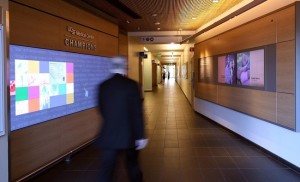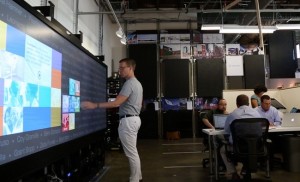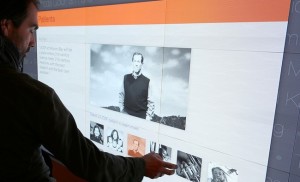Subscribe Now
Digital Displays in the Healthcare Environment
Interactive donor walls, digital wayfinding signage and patient-facing digital messaging platforms are all becoming increasingly common in healthcare facilities. This growth is being driven by three important trends, each of which brings with it a unique combination of opportunities and challenges.
- Lower cost and greater selection – Costs for digital displays continue to decline, and new technologies have come onto the market. While hospitals are finding more options on the table, they are often confounded by the complex technology decisions before them.
- Better technology – Hardware and software products continue to improve every year. New features are added, which offer hospitals new tools to manage communications with visitors. However, the challenge of determining which features are critical, and then integrating the pieces into a functioning system, is often well outside the capabilities of hospital IT groups.
- Higher expectations – The general public is utilizing more and increasingly complex technology on a daily basis. This translates into higher expectations for the technology that will be provided in the healthcare environment. This is forcing hospitals to sort through all of the things they could do, in order to determine what they should do.
These fast-moving trends are leading to questions that are pushing hospitals far outside of their comfort zones: Which hardware and software do we need? How do we know it will all work together? And will we get the right results?
The design process for the recently completed interactive donor wall at the University of California Medical Center San Francisco at Mission Bay yielded some insight into what hospitals need to consider as they undertake a digital signage project.
The 4-by-13 interactive wall is the centerpiece of an installation that tells the stories of UCSF Medical Center’s donors. The installation includes architectural finishes, lighting, a custom audio environment, a variety of static graphic panels, looping video on LCD displays and the interactive wall. The wall features a gesture-controlled attract mode that captures the attention of visitors walking past the installation. Then, with curiosity piqued, visitors can use the wall’s touch-screen capabilities to learn more about donors, and also explore engaging, interactive content about the institution’s hospitals, faculty, staff and programs. The wall’s sophisticated hardware and software allow it to accommodate multiple simultaneous users along its 13-foot length.
Insight One: First Focus on Defining User Experience
The needs, goals and objectives of patients, visitors, caregivers and staff should drive all other decisions. This means focusing first on defining the user experience, and then letting that inform critical technology decisions, rather than evaluating technology in a user-experience vacuum.
In the case of the UCSF Medical Center interactive donor wall, a series of workshops were facilitated that yielded extensive data. The format allowed all groups an opportunity to express their concerns in collaborative sessions. The result was a set of design parameters that established a broad consensus. The most successful session focused on selecting content for the wall. Eight stakeholders were assembled around a table, and each brought examples of the content they wanted on the wall. In the end, an exceptional model for storytelling was developed.

The foundation for a successful system is formed in work sessions with a full range of stakeholders.
Insight Two: Design Hardware, Software, Interactivity and Content Together
Designing or selecting any component of the system without fully considering the other components can be almost as damaging as beginning the process without a clear understanding of the user experience. Hardware decisions, in particular, need to be made with a clear understanding of the project’s content requirements, the hardware’s lifecycle costs and infrastructure limitations.
The UCSF Medical Center interactive wall required a display that produced very little heat in order to avoid costly retrofits to the HVAC system. This criterion enabled the team to prioritize decision-making as far as considering LCD displays, digital light processing tiles, laser phosphor display tiles and high-resolution LED displays. Each technology has its own set of strengths and weaknesses with regard to heat output, resolution, brightness, color range, initial and lifecycle costs and maintenance needs. Without a detailed understanding of the program and of each system component, it is very difficult to make an intelligent technology selection based on the critical criteria.
Insight Three: Start Planning for Operations Immediately
Failure to give advanced consideration to post-launch issues can doom even the most well-designed digital signage program. For a system to be successful, the institution and its consultants must take time during the planning process to answer some key questions related to both content and operations.
Questions to consider about the content development and management process include:
- Who will create the content for launch, and what assets are available?
- Who will update content once the system goes live?
- How frequently will updates occur and what budget is required?
- What skill sets are required to update content?
Operational issues to consider before beginning the design process include:
- Who will be responsible for ensuring the system is operational at all times?
- What internal and external maintenance and repair support is available, and who will manage this?
- What will operations cost, and where will the money come from?
Recent trends in the digital signage industry offer increased opportunities for hospitals to engage with visitors, but institutions must properly manage the related complexities for a project to succeed. Hospitals are expected to continue considering new applications for digital signage. The next round of technology will likely offer better resolution, lower energy consumption, lower heat output, better viewing characteristics and decreased maintenance.
If design challenges are to be successfully addressed in an environment of constant technology churn, it’s important to focus on defining the user experience first, designing systems rather than selecting components and planning for operations. Design teams that build their planning process around these three insights will be able to deliver effective systems that satisfy user and stakeholder needs, both initially and long term.
Tags: Architecture, Digital, Donor Signage, Interactive, Wayfinding
Posted May 12, 2015
More Articles:
- CxA Workshop & Exam
Apr 29, 2024 – Apr 30, 2024 - EMP Seminar & Exam at CxEnergy 2024
Apr 29, 2024 – Apr 30, 2024 - CxEnergy
Apr 29, 2024 – May 2, 2024 - PHCC West 2024
Apr 29, 2024 – May 2, 2024 - Lean in Design Forum 2024
May 1, 2024 – May 2, 2024 - IFMA’s Facility Fusion Conference & Expo
May 5, 2024 – May 7, 2024 - ASHE Academy 2024
May 6, 2024 – May 10, 2024













